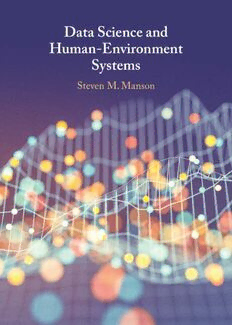Table Of ContentDATA SCIENCE AND HUMAN-ENVIRONMENT SYSTEMS
Transformation of the Earth’s social and ecological systems is occurring at a rate and
magnitudeunparalleledinhumanexperience.Datascienceisarevolutionarynewwayto
understand human-environment relationships at the heart of pressing challenges like
climate change and sustainable development. However, data science faces serious
shortcomings when it comes to human-environment research. There are challenges with
social and environmental data, the methods that manipulate and analyze the information,
and the theory underlying the data science itself, as well as significant legal, ethical, and
policyconcerns.Thistimelybookoffersacomprehensive,balanced,andaccessibleaccount
ofthepromiseandproblemsofthisworkintermsofdata,methods,theory,andpolicy.It
demonstrates the need for data scientists to work with human-environment scholars to
tacklepressingreal-worldproblems,makingitidealforresearchersandgraduatestudentsin
Earthandenvironmentalscience,datascience,andtheenvironmentalsocialsciences.
steven m. manson is a professor in the Department of Geography,
Environment, and Society at the University of Minnesota, and a Fellow of the
InstituteontheEnvironment.Hecombinesenvironmental,social,andinformation
science to understand complex human-environment systems. He has won awards
from organizations including the US National Aeronautics and Space
Administration, the University Consortium for Geographic Information Science,
andtheEcologicalSocietyofAmerica.
Published online by Cambridge University Press
Published online by Cambridge University Press
DATA SCIENCE AND HUMAN-
ENVIRONMENT SYSTEMS
STEVEN M. MANSON
UniversityofMinnesota
Published online by Cambridge University Press
ShaftesburyRoad,CambridgeCB28EA,UnitedKingdom
OneLibertyPlaza,20thFloor,NewYork,NY10006,USA
477WilliamstownRoad,PortMelbourne,VIC3207,Australia
314–321,3rdFloor,Plot3,SplendorForum,JasolaDistrictCentre,NewDelhi–110025,India
103PenangRoad,#05–06/07,VisioncrestCommercial,Singapore238467
CambridgeUniversityPressispartofCambridgeUniversityPress&Assessment,
adepartmentoftheUniversityofCambridge.
WesharetheUniversity’smissiontocontributetosocietythroughthepursuitof
education,learningandresearchatthehighestinternationallevelsofexcellence.
www.cambridge.org
Informationonthistitle:www.cambridge.org/9781108486286
DOI:10.1017/9781108638838
©StevenM.Manson2023
Thispublicationisincopyright.Subjecttostatutoryexceptionandtotheprovisions
ofrelevantcollectivelicensingagreements,noreproductionofanypartmaytake
placewithoutthewrittenpermissionofCambridgeUniversityPress&Assessment.
Firstpublished2023
AcataloguerecordforthispublicationisavailablefromtheBritishLibrary.
ISBN978-1-108-48628-6Hardback
CambridgeUniversityPress&Assessmenthasnoresponsibilityforthepersistence
oraccuracyofURLsforexternalorthird-partyinternetwebsitesreferredtointhis
publicationanddoesnotguaranteethatanycontentonsuchwebsitesis,orwillremain,
accurateorappropriate.
Published online by Cambridge University Press
Contents
ListofFigures pagevi
ListofTables vii
Preface ix
Acknowledgments xi
1 DataScienceandHuman-EnvironmentSystems 1
2 DataGapsandPotential 27
3 BigMethods,BigMesses,BigSolutions 76
4 TheoryandthePerilsofBlackBoxScience 120
5 PolicyDilemmas 161
6 WaysForwardfortheDataScienceofHuman-EnvironmentSystems 198
References 213
Index 252
Platescanbefoundbetweenpages131and132.
v
Published online by Cambridge University Press
Figures
1.1 Sizeofglobaldataholdings(2010–25)(Reinseletal.2018). page9
ReprintedwithpermissionfromtheInternationalDataCorporation.
2.1 CrowdsourcingmethodsdefinedbyintersectionsoftheInternet, 55
citizens,andsensors/smartdevices(Mulleretal.2015).Reprinted
withpermissionfromJohnWiley&Sons.
3.1 Neuralnetworkstructurewithinput,hidden,andoutputlayers(Marcus2018). 79
Reprintedwithpermissionofauthor.
3.2 DigitalCurationCentreCurationLifecycleModel(Higgins2008). 86
ReprintedwithpermissionoftheDigitalCurationCentre(www.dcc.ac.uk);
CC-BY4.0(creativecommons.org/licenses/by/4.0/).Modifiedtorenderin
grayscale.
3.3 Wherearebigdatastored?(Reinseletal.2018).Reprintedwithpermission 96
fromtheInternationalDataCorporation.
3.4 Sourcesofuncertaintyinspatialdata(Kedronetal.2021).Reprintedwith 102
permissionfromJohnWiley&Sons.
3.5 Percentageofjournalswithavailabilityrequirements(Klemens2021). 104
Reprintedwithpermissionofauthor.
4.1 Formsofscientificinquiry(adaptedfromElliottetal.2016).Reprinted 123
withpermissionfromOxfordUniversityPress.
4.2 Predictionversusexplanation(adaptedfromWaller&Fawcett2013). 126
ReprintedwithpermissionfromJohnWiley&Sons.
4.3 Skillsneededindatascience(Chang&Grady2015). 152
5.1 Costofbroadbandsubscriptionasapercentageofaverageyearly 174
income(Grahametal.2015).ReprintedwithpermissionofJohnWiley
&Sons;CC-BY4.0(creativecommons.org/licenses/by/4.0/).Modified
torenderhalfofmapingrayscale.
5.2 SustainableDevelopmentGoals(UnitedNations2020).Usedwith 183
permission.Thecontentofthispublicationhasnotbeenapproved
bytheUnitedNationsanddoesnotreflecttheviewsoftheUnitedNations
oritsofficialsormemberstates.
6.1 Data–information–knowledge–wisdompyramidforhuman-environment 201
challenges(adaptedfromLokersetal.2016).Reprintedwithpermission
fromElsevier.
vi
Published online by Cambridge University Press
Tables
1.1 Sizeofbigdataintermsofspeedandstoragedemands page 10
1.2 Datascienceworkflowandexamplesfromhuman-environmentresearch 16
1.3 Technologyintermsofvaluesversusagency 21
2.1 Administrativedataversusbigdata 43
2.2 Cellphonesandsensorsources 49
2.3 Transactionaldatacategoriesandexamples 54
4.1 Smartcitiesresearchgoalsanddatascience 156
5.1 Characteristicsofeffectiveopendatause 177
6.1 Infrastructuredimensions 205
vii
Published online by Cambridge University Press
Published online by Cambridge University Press
Preface
The primary rationale for this book is that researchers play an essential part in
addressing the many challenges that beset the world. Data science is increasingly
important to understanding the human-environment relationships at the heart of
such critical issues as climate change, natural hazards, and sustainable
development.
Anarrowerreason(undoubtedlysharedbymanyauthors)isthatIcouldnotfind
abookquitelikethisone.Thereisexcellentworkoutthere,andIcitemuchofit,
but I wanted a volume firmly at the intersection of information, social, and
environmentalsciences.Thereismuchroomtobridgevariouscampsofscholarly
workonbigdataanddatascienceforhuman-environmentsystems.Ofcourse,there
is the risk of trying to cover too much ground or not offering enough. Hopefully,
thatisnottoomuchofaproblem,butwewillsee.
Wehavegotourworkcutoutforus.Datascienceandcognatefieldslikebigdata
and artificial intelligence hold great promise for studying human-environment
systems. At the same time, human-environment research offers much to data
science in terms of sophisticated approaches to compelling real-world problems.
Seriousshortcomingsexistinsocialandenvironmentaldata,someofwhichweare
onlybeginningtosee.Therearemanywaysthatwecanmakeourmethodsbetter
and,atthesametime,workonthetheoriesunderlyingthedatascienceofhuman-
environment systems. We also need to be aware of significant legal, ethical, and
policy concerns. However, with luck, we can use the tools of data science and
human-environmentresearchtoaddresstheseconcerns.
Once we get past the starry-eyed embrace of data science or its often justified
critiques, there is a middle ground or many potential middle grounds in human-
environment research. This sounds pollyannaish, but we must collaborate to deal
withourcollectivechallenges.Itcanbehardtoremainhopefulinthefaceofwhat
seemstobeoneunfoldingcalamityafteranother–war,famine,disease,disaster–
that are usually expressions of long-running human–environment dynamics.
ix
https://doi.org/10.1017/9781108638838.001 Published online by Cambridge University Press

